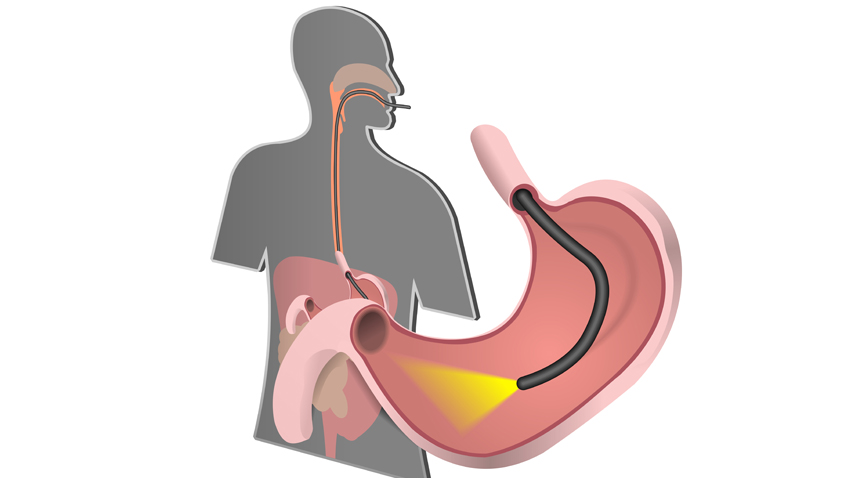UGI Endoscopy, also called upper gastrointestinal endoscopy, allows the best gastroenterologist to look for inflammations, ulcers bleeding, infections or tumours in the inner lining of the esophagus, first part of the small intestine and your stomach. A small viewing tool called endoscope is inserted through the mouth down your throat to take pictures of the stomach and esophagus.
Overview
UGI Endoscopy, also called upper gastrointestinal endoscopy, allows the doctor to view the inside lining of the stomach, esophagus, and upper gastrointestinal tract by using a flexible, thin tube, called endoscope. The tube is inserted into your mouth and gently pushed down your throat into the stomach and esophagus.
The procedure of UGI Endoscopy enables the top gastroenterologist to look for tumours, ulcers, bleeding, infections and inflammations. During the procedure, the doctor removes polyps, called tissue samples and use the scope to treat bleeding. Grave symptoms like vomiting blood, upper belly bloating or pain, unexplained weight loss, trouble in swallowing and vomiting are examined with UGI Endoscopic procedure.
The reasons for endoscope are some of the other reasons include checking any injury to the esophagus, treating upper GI bleeding, looking for any blockage between the duodenum and the stomach and removing any foreign object that was swallowed accidentally.
Before endoscopic procedure, you are required to follow a few things mentioned as below.
Before the Treatment
- Let your doctor know if you are allergic to certain medications and anaesthetics. Do inform him about the types of medicines you are currently taking and about any health conditions like heart problems, possibility of pregnancy, diabetes, sugar, etc.
- Those who have bleeding problems usually rely on blood thinners, but this should be mentioned to your doctor since the medicines may interfere with the procedure.
- If you had prior radiation treatments or surgery to your esophagus, upper intestinal tract and stomach, then that should be specified to the doctor.
- You should not drink or eat anything 6-8 hours before the procedure. Keeping your stomach clean enables your doctor view the internals clearly. However, there are chances of vomiting and things can turn complicated if the vomit enters the lung, which is, however, a rare case.
- Consult with your gastroenterologist regarding the benefits of the test, risks associated with it and how the results will help improve your health. Usually, patients are recommended to stop taking iron supplements, aspirin products, non-steroidal anti-inflammatory drugs for at least 7-14 days before the treatment. Prohibit antacids or sucralfate that makes it difficult for the doctor to clearly view the upper GI tract.
- Once all doubts are cleared, you may have to sign a consent form that says you understand the risks of the tests.
- Before taking you to the examination room, you are asked to wear a gown and remove jewelleries, glasses, contact lenses. Empty your bladder prior to the test to feel comfortable while lying down.
How is it performed
Upper GI Endoscopy is generally performed by a gastroenterologist. It may also be performed by specially trained surgeons, internists and family medicine doctors. The procedure does not require you to stay at the hospital. Read to know how UGI endoscopy is performed:
- The procedure is performed in a clinic, or at a doctor’s office or in a hospital.
- Blood tests are done to evaluate any clotting problems or low blood counts. To enable a smooth passing of endoscope down the throat, the area is numbed with anaesthetic spray or lozenge. This makes it easier to insert the endoscope and relax your gag reflex.
- A sedative or pain medicine is given through an intravenous line in the hand or arm to enable you feel drowsy and relax.
- You are asked to lie down on your left side with your mouth bent slightly forward. To safeguard your teeth during the procedure a mouth guard is placed in the mouth. The doctor advices you to swallow to help the tube slowly move inside the mouth. You should not feel afraid since the scope is very thin, causing no breathing problem.
- The gastroenterologist advices you to tilt your head upwards once the scope is inside the esophagus. This enables the scope to slide down smoothly through the esophagus. Saliva accumulated in your mouth is sucked out with a suction device. However, you should not swallow unless you are asked to.
- The instrument inserted inside has a camera fitted to it that captures images of the walls of esophagus, duodenum and stomach, which the doctor examines on a computer screen.
- In case of any blockage or obstruction during the procedure, the doctor injects water and air through the scope to clear the pathway. For clearer visuals, the physician exerts pressure on your belly or tells you to change positions.
- In case of bleeding or growths, tiny tools like clips, forceps, and swabs are used to remove growths or collect tissue samples.
- Usually, the test takes 30-45 minutes but it may take longer, depending upon what is found and where it is found during the examination. Once complete, the endoscope is gently withdrawn.
Recovery
The patient is kept under observation for 1-2 hours after the procedure until the effects of anaesthesia wear off. You can drink or eat only after your throat gets back to normal. It takes a couple of hours to recover, but the sooner you feel better you are allowed to go home. Make sure you do not operate a machinery or drive for at least 12 hours after the test.
Avoid drinking alcohol for 24 hours after the procedure. You are advised when to go back to your normal activities and diet. It is normal to feel pain, nausea, mild cramping and bloating after the procedure. However, the recovery time of UGI Endoscopy is quick and gets over in a day. In case, you feel sharp pain or other discomfort, inform it to the doctor.






Leave A Comment
You must be logged in to post a comment.